September is Microplastic Awareness Month
 |
Kudos to those hotels that are switching to dispensers instead of tiny plastic bottles of shampoo, conditioner and shower gel. |
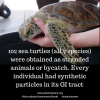 |
102 sea turtles (all 7 species) were obtained as stranded animals or bycatch. Every individual had synthetic particles in its GI tract |
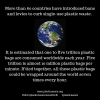 |
More than 60 countries have introduced bans and levies to curb single-use plastic waste. It is estimated that one to five trillion plastic bags are consumed worldwide each year. Five trillion is almost 10 million plastic bags per minute. If tied together, all these plastic bags could be wrapped around the world seven times every hour. |
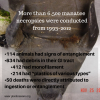 |
More than 6500 necropsies were conducted on manatees from 1993-2012. •114 animals had signs of entanglement •634 had debris in their GI tract •412 had monofilament •214 had “plastics of various types” •50 deaths were directly attributed to ingestion or entanglement
|
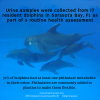 |
In this study, published in 2018, the 17 dolphins studied ranged in age from 2 to 34 years. Almost three-quarters of the animals had metabolites of phthalates in their urine. Phthalates are one type of plasticizer that is added to plastics. |
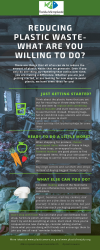 |
Reducing Plastic Waste-What are you willing to do? There are things that all of us can do to reduce the amount of plastic waste that we generate. Even if you only do one thing, by repeating that action over time, you are making a difference. Whether you are just getting started, or are looking for new ways to avoid plastic, we have some ideas for you! Just getting started? Think about the plastic items that you set out for recycling or throw away the most. Pick one item to replace with something that is reusable and start training yourself to use that item instead. Shopping bags, hot or cold drink cups, utensils and straws are good places to start! Check out http://bit.ly/plasticpledge for some ideas Ready to do a little more? When shopping for produce, choose unwrapped items instead of those in bags, on foam trays, or wrapped in plastic. Farmers markets are good places to find unwrapped items. Bring your own paper or mesh bag to use for loose beans, berries, etc. Buy large carrots and cut them into strips instead of buying bagged "baby" carrots. What else can you do? Consider making some of the food items that you otherwise buy regularly in plastic containers. Yogurt, hummus, iced tea, cookies, and granola are a few ideas to try making yourself. It takes a bit more time, but just think how much packaging you will save! Don't stop with food! You can make your own beeswax food wrap, furniture polish, window cleaner and even toothpaste! Don't try and do everything at once. Start small. Once you've conquered one new challenge, consider adding another. Share what you are doing with friends and encourage them to join you (we all need 'reminder buddies'). |
 |
Researchers estimated this from numerous studies that have reported microplastics found in various food and beverage items... |
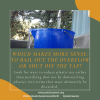 |
Only a small amount of plastic is recycled. Most of that is turned into products that then cannot be recycled (because they are mixed with other plastics, or because the polymers are weakened by the recycling process). Rather than finding new ways to utilize single-use plastics, we need to look for ways to avoid using them in the first place. |
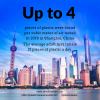 |
Up to four pieces of plastic were pound per cubic meter of air tested in Shanghai, China (2018). The average adult may inhale 21 pieces of plastic a day. |
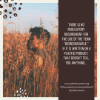 |
There is no regulatory requirement for the use of the term "biodegradable." If you see it on a plastic product, doesn’t tell you anything. Everything is probably biodegradable given enough time. But we need products that will turn into harmless products in a reasonable time frame, not a geologic one. |
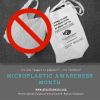 |
Plastic shopping bags are often not recycled (have you ever seen one blowing down the street, or tangled in a bush, or floating in the water?) Reusable shopping bags (especially those made of cotton) are sturdy, strong, washable and don’t contribute to plastic pollution. Can you train yourself to remember your reusable bags when shopping? Keeping a stack in the car is a good start! |
 |
About 50 million single use plastic water bottles are thrown away in the US every day. Using a reusable drink container instead of single-use ones can greatly reduce the amount of plastic waste we generate. It is estimated that 1.5 to 4.5 % of plastic waste generated ends up in the ocean. This means that annually, about 275-820 MILLION water bottles used in the US could end up in the ocean. |
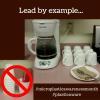 |
Polystyrene foam cups and plastic stirrers are common in workplaces. Consider bringing your own washable hot beverage cup from home, or see if your workplace will replace their foam cups with washable ones. Using washable spoons rather than plastic stirrers will also cut down on plastic waste. |
 |
Petroleum-based plastics never biodegrade into their constituent elements. This means that almost every piece of plastic ever made still exists (much of it is now a multitude of tiny pieces of plastic). Every day the amount of plastic waste increases. The term “Anthropocene” has been proposed for our current geologic era because of the layer of plastic debris expected to be formed. |
 |
Do you know what you are wearing? Synthetic fabrics like polyester, nylon, acrylic, polypropylene and microfiber may feel soft, but they shed microscopic plastic fibers when washed. Those fibers are ending up in the environment, especially in our lakes and ocean. They are eaten (either deliberately or accidentally) by aquatic organisms. |
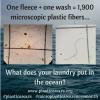 |
Synthetic fabrics (e.g. polyester, nylon, acrylic, microfiber) shed microscopic plastic fibers when washed. Many of these fibers pass through the wastewater treatment plants and are discharged into local waterways in wastewater effluent. The best way to reduce this source of microplastics is to choose natural fabrics (e.g. cotton, linen, hemp, wool, silk) when purchasing clothing, linens, cleaning supplies etc. |
 |
Scientists estimate that in 2010 alone, between 4 and 12 million metric tons of plastic washed into the ocean. This number is expected to increase each year. What can you do to reduce your contribution to this problem? |
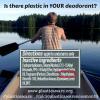 |
If your deodorant (or other personal care products) contains polyethylene, that’s plastic. Why is plastic in there? Sometimes plastics are added as exfoliants, but they are also inexpensive fillers. What happens to these plastics? Ultimately most end up going down the drain (when we bathe or wash our clothes). Let’s try and keep these microplastics out of the waste stream by selecting products that do not contain polyethylene. |
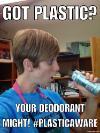 |
Many people are aware that personal care products like facial scrub and toothpaste might contain plastic “microbeads.” Did you know that your deodorant, body lotion and makeup products also often contain plastic? Check the labels and avoid products containing polyethylene. Only rinse-off cosmetics that are designed to cleanse or exfoliate are covered by the Microbead-Free Waters Act of 2015. |
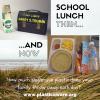 |
How times have changed. We used to have washable, reusable containers for portable lunches. Today, our convenience lunches are wrapped (sometimes more than once!) in plastic. Can you reduce your plastic waste by taking a few minutes to pack lunches in washable containers? |
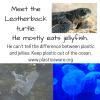 |
When plastics get into the ocean, they are often eaten by marine organisms. Even the tiniest marine life (plankton) can eat microplastics. Consumption of plastic can be deadly for some marine animals. Photo credits: (turtle) NOAA; (plastic bag jellyfish) Wikimedia Commons user seegraswiese. This file is licensed under the Creative Commons Attribution-Share Alike 3.0 Unported license; (blue jellies) Wikimedia Commons user ProjectManhattan. This file is made available under the Creative Commons CC0 1.0 Universal Public Domain Dedication |
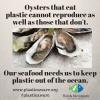 |
Pacific oysters that were fed polystyrene (plastic) microbeads along with algae for a 2 month period had significant decreases in egg production and sperm mobility. Additionally, larval yield and survival were lower in these oysters compared to controls. The authors theorize that the oysters put energy into clearing the plastics (“elevated maintenance”), reducing the energy available for reproduction. |
 |
Petroleum-based plastics do seem to “go away”—we are probably all familiar with sun-baked plastic items becoming brittle and breaking into small pieces. This photodegradation continues until plastics turn into plastic dust. But these plastics do not return to their elemental form (carbon, hydrogen, oxygen, nitrogen, chlorine, sulfur), so they never actually biodegrade. |
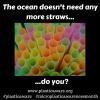 |
One of the top items collected during beach cleanups is drinking straws. These are particularly abundant on beaches where restaurants overlook the water. How can you help keep these plastic straws out of the ocean? Get in the habit of saying, “No straw, please” when you order a drink. If you really need a straw, bring your own washable straw when dining out. And check out http://onelessstraw.org! |
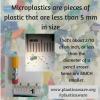 |
There are two types of microplastics—primary microplastics are those that are deliberately made to be less than 5 mm in size. These include “microbeads” in many personal care products, and “nurdles” which are the form in which plastic is shipped to manufacturers. Secondary microplastics started off as larger plastic items, but have degraded over time into smaller and smaller pieces. |
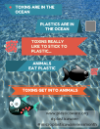 |
Toxins that are present in the ocean (nasty chemicals like PCBs, PAHs, and DDTs) adsorb to the surface of plastics in the water. They actually can become concentrated there—as much as a million times more concentrated on the plastic than in the water. When organisms eat the plastics, or come into contact with the plastics (e.g. in the sediment), the toxins can leach into the animals’ tissues. |
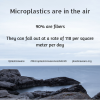 |
|
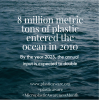 |
How can you visualize 8 million metric tons of plastic? Dr. Jenna Jambeck (UGA) says to think of 5 grocery bags of plastic for every foot of coastline (of the 192 countries studied for this research.) By 2025, the total amount of plastic in the ocean is expected to have increased to 80 million metric tons, and the annual input is expected to have doubled to around 17 million metric tons. |
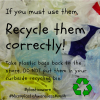 |
While you cannot recycle plastic bags in your curbside recycling bin (they will get tangled up in the machinery used to sort the recyclables), you can do so at many stores. "Plastic bags" includes paper towel wrappers, many vegetable bags, newspaper delivery bags and many more (look for the #2 or #4 recycle logo). |
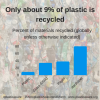 |
Unlike glass, steel and paper, most plastics can only be recycled once. While it is best to try and avoid having plastic waste, if you do have recyclable plastic items, please do try and recycle them. Other posts this month will explain how best to recycle certain types of plastic items, as not all of these can be recycled in a curbside recycling bin. |
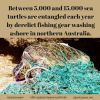 |
Much fishing gear (nets, ropes, line, buoys) is made of plastic. In its original form, derelict gear can become an entanglement risk. Over time, much of the gear will degrade into microplastic fibers and fragments, where it may impact smaller aquatic life forms. |
 |
Note that it is not only the washing process that produces fibers. I wonder what proportion of the microscopic fibers escapes through the dryer's filter into the environment... |
| TedEd video: Nurdles Quest for Ocean Domination | Nurdles. Who would have thought that something with such a fun name could be such a problem? This 5-minute video provides a great overview about the ocean's problem with plastic pollution. |
